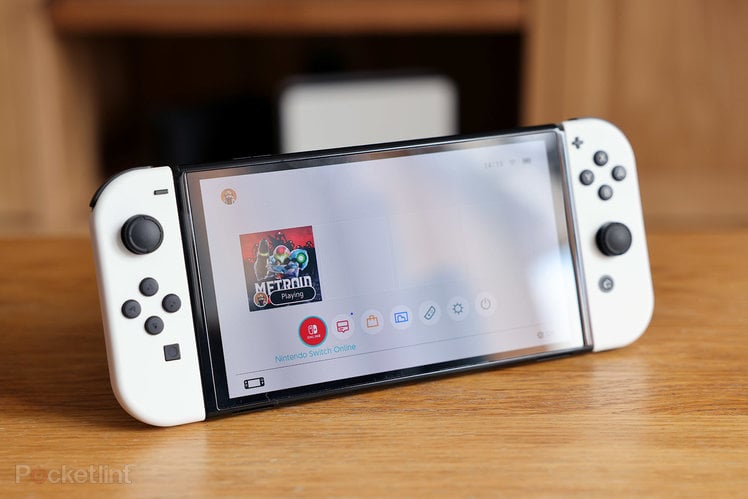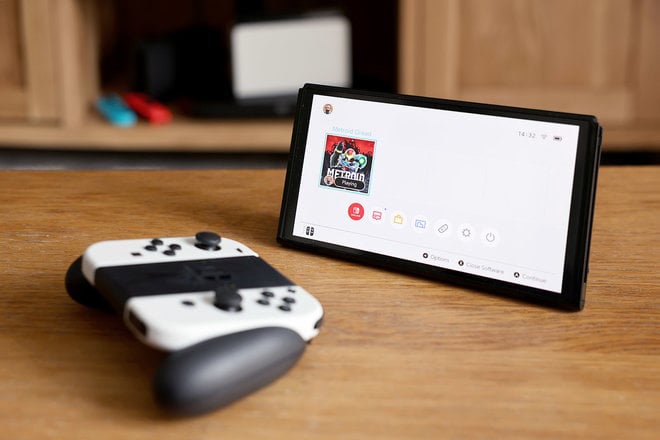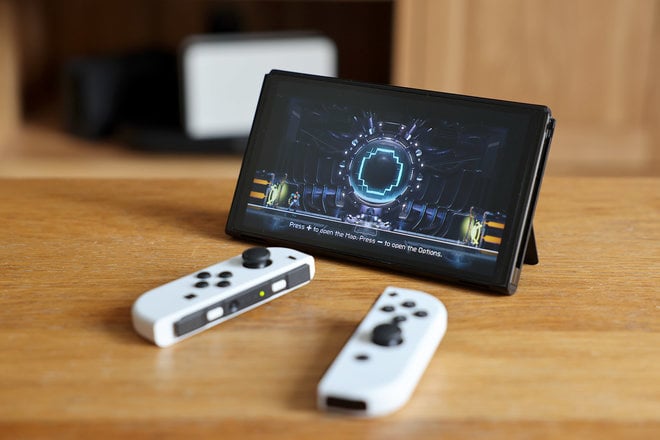
There are two ways to look at the Nintendo Switch OLED model: positively, as an all-round improved console with bigger, brighter and better screen tech; or cynically, as a half-baked progression over the original console, missing out on various opportunities to further improve and enhance the Switch experience.
From our perspective the original Switch was a total game-changer console, one that we’ve loved using for years now, so to have one that improves upon the portable play side of things can only be a good thing.
So if you’re yet to jump on the Nintendo train to joy town then, well, clearly the Switch OLED model is the way to do it. Here’s how we’ve found it to compare to the original console and why we think it’s the Switch to rule them all.
What’s different?
- 7-inch OLED display
- 64GB built-in storage
- Enhanced audio output
- Large, multi-positional rear kickstand
- Dock includes Ethernet/LAN port (in place of one USB)
As the product name tells you loud and proud: the third Switch model (after the original and Lite) comes with an OLED screen. This self-emitting technology isn’t necessarily brighter than LCD – although, as our side-by-side pictures show you, the OLED panel here very much is – but it’s always known for richer colours and deeper blacks. The OLED model has ‘cleaner’ whites, too, meaning it’s cooler, kind of more blue – but in a more natural fashion.
But the biggest take-away about this screen is that it’s bigger than the one in the original Switch: the OLED panel measures 7-inches on the diagonal, compared to 6.2-inches of the original’s LCD panel. However, this doesn’t make the OLED model console’s overall footprint really any bigger – it’s simply that the bezel has been eaten away, so there’s less distracting black stuff at the edges, delivering a more expansive viewpoint (albeit not quite edge-to-edge).

The Switch OLED’s dimensions do differ a tiny amount compared to the original, and it’s a little heavier, but having handled both one after the other for the sake of this review, we’re sure you really wouldn’t know. The physical ‘height’ is identical between both products – which is great as it means Joy-Con controllers are interchangeable, should you have a spare set to make use of and fancy mixing things up a bit.
Some of that dimension increase is down to the OLED model’s new, larger integrated kickstand. This is a vast improvement over the tiny stick-like one in the original Switch, making desktop mode – where you can detach the Joy-Cons to play as if the Switch is a mini TV – far more viable. It holds strong and is adjustable through a wide array of angles. Bravo.
Is OLED really better?The Switch OLED also comes in a white colourway finish, helping it to stand apart from the various multi-colour finishes (although the normal neon option is also available). Even the dock is finished in white, giving it a clean, cool look. The dock adds a LAN/Ethernet port at the expense of the internal USB socket, but this is ideal for ensuring solid connectivity to a router – besides, there are two USB ports on the exterior of the dock anyway.
- Console dimensions (with Joy-Con controllers): 102mm x 242mm x 13.9mm
- Console weight (with Joy-Con controllers): 420g / (without Joy-Con controllers): 320g
- 7-inch OLED panel, 720 x 1280 native resolution (1920 x 1080 60fps maximum TV output)
The Switch OLED model is a clear winner if you’re looking to play when on the go, thanks to that luscious screen. Thing is, that’s kind of the point of the Switch Lite (the one Switch console that can’t connect to a TV), which has a smaller and inferior screen.
As the OLED model adds no extra grunt to power proceedings over the original Switch, if you’re largely a TV screen player then, well, there’s zero difference between the two main console options. It’s identical in terms of graphical fidelity – it’s ‘HD Ready’ 720p on the portable screen, upping to Full HD 1080p on a TV screen – it’s all the same.
That’s where the cynical angle could creep in: a lot of people were expecting a ‘Switch Pro’ instead of this OLED model, but that’s not the deal here. It’s more a mid-lifecycle change-up. But if you’ve never bought a Switch before now then, well, the OLED model is the obvious one to go for in every regard.
Furthermore, there’s no distinctive battery improvement. The wide-reaching scope from Nintendo’s word is between four-and-a-half and nine hours on a single charge. Playing Metroid Dread – the ‘launch title’ along with the OLED model – and you’ll get over five hours of portable play, no problems (without getting five hours into the game, as it’s unexpectedly difficult!). Small criticism: we wish the charging, at three hours via USB-C/the dock, was a little speedier.
Oh, and the whole Switch family still doesn’t have much appetite for third-party apps. There’s still no Netflix, for example, which is a shame given the OLED model’s new-and-improved screen. That said, you buy a Switch to game, not watch Gossip Girl (we’re not judging).
Super games
- Play on TV, on-the-go, on desktop
- Limited third-party apps (no Netflix, for example)
- Nintendo eShop downloads or cartridge purchases
All that said, it’s difficult to not let the Switch OLED model sweep you away with its sheer brilliance. Because let’s face it, you buy into Nintendo for its first-party games. Many of which are absolute bangers. Everyone knows it: Nintendo has made – and continues to make – some of the very best games, ever.

That, above all else, is what sells the Switch series. Whether you want to buy the OLED model for optimum on-the-go potential, or save a little bit of cash and use an original Switch primarily for TV-based use, there’s a whole variety of quality games on offer.
Every time a AAA title graces our offices it seems to succeed: from Zelda Breath of the Wild delivering our favourite ever Link adventure; to Super Mario Odyssey delivering charm and imagination to 3D platforming fun; to Bowser’s Fury delivering new levels of creativity and madness; to Animal Crossing New Horizons‘ record-breaking popularity.
